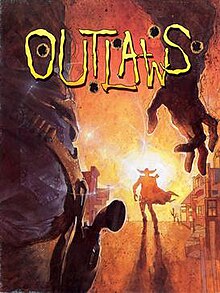
Quake II is a 1997 first-person shooter video game developed by id Software and published by Activision. It is the second installment of the Quake series, following Quake. The game's storyline is continued in its expansions, including one tying in Quake II and the first game, and Quake 4.

Quake is a first-person shooter game developed by id Software and published by GT Interactive. The first game in the Quake series, it was originally released for MS-DOS, Microsoft Windows and Linux in 1996, followed by Mac OS and Sega Saturn in 1997 and Nintendo 64 in 1998. In the game, players must find their way through various maze-like, medieval environments while battling monsters using an array of weaponry. Quake takes inspiration from gothic fiction and the works of H. P. Lovecraft.

Star Wars Jedi Knight II: Jedi Outcast is a 2002 first- and third-person shooter video game. The Microsoft Windows was developed by Raven Software, the Mac OS X version by Westlake Interactive, and the Xbox and GameCube versions by Vicarious Visions; most versions were published by LucasArts, with only the Mac version published by Aspyr. The game is a sequel to 1997's Star Wars Jedi Knight: Dark Forces II, and the third main installment in the Star Wars: Jedi Knight series. The single-player campaign, set in the fictional Star Wars expanded universe two years after the Mysteries of the Sith expansion for Dark Forces II, follows returning protagonist Kyle Katarn, a mercenary working for the New Republic and former Jedi who cut his connection to the Force. Katarn must return to his Jedi ways to stop a branch of the Imperial Remnant led by the Dark Jedi Desann from empowering their army with the Force.

Star Wars: X-Wing vs. TIE Fighter is a 1997 space combat game developed by Totally Games for LucasArts. It is the third installment of the X-Wing series.
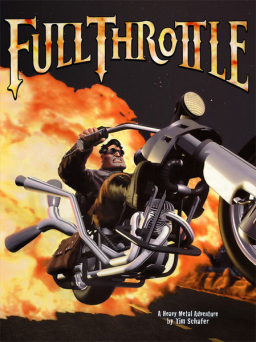
Full Throttle is a 1995 graphic adventure video game developed by LucasArts and designed by Tim Schafer. It was Schafer's first game as project lead and head writer and designer, after having worked on other LucasArts titles including The Secret of Monkey Island (1990), Monkey Island 2: LeChuck's Revenge (1991), and Day of the Tentacle (1993). Set in the near future, the story follows motorcycle gang leader Ben, who must clear his name after being framed for the murder of a beloved motorcycle manufacturing mogul. A remastered version of the game was developed by Double Fine Productions and was released in April 2017 for Windows, PlayStation 4 and PlayStation Vita, with later ports for iOS and Xbox One.
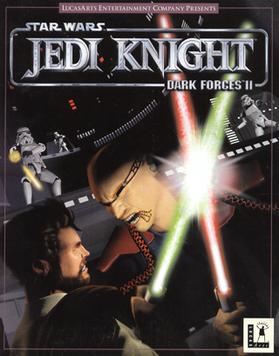
Star Wars Jedi Knight: Dark Forces II is a 1997 first-person shooter video game developed and published by LucasArts for Microsoft Windows. It is the sequel to 1995's Star Wars: Dark Forces, and the second installment in the Star Wars: Jedi Knight series. The story, set in the fictional Star Wars expanded universe one year after the film Return of the Jedi, follows returning protagonist Kyle Katarn, a mercenary working for the New Republic, who discovers his connection to the Force and "The Valley of the Jedi", an ancient source of power. With his father having been murdered years prior by the Dark Jedi Jerec and his followers over the Valley's location, Katarn embarks on a quest to confront his father's killers and find the Valley before they do.

Star Wars Jedi Knight: Jedi Academy is a first- and third-person shooter video game developed by Raven Software and published by LucasArts for Microsoft Windows, OS X and Xbox in 2003. Vicarious Visions was responsible for the development of the Xbox version. The game is a sequel to 2002's Star Wars Jedi Knight II: Jedi Outcast and the fourth and final installment in the Star Wars: Jedi Knight series. The single-player story, set in the fictional Star Wars expanded universe two years after Jedi Outcast, follows Jaden Korr, a new student at Luke Skywalker's Jedi Academy under the tutelage of the previous games' protagonist, Kyle Katarn. As Jaden, players are tasked with investigating a Dark Jedi cult called the Disciples of Ragnos, while slowly learning the ways of the Force and committing themselves to either the light side or the dark side.

Dungeon Siege is an action role-playing game developed by Gas Powered Games and published by Microsoft in April 2002, for Microsoft Windows, and the following year by Destineer for Mac OS X. Set in the pseudo-medieval kingdom of Ehb, the high fantasy game follows a young farmer and her companions as they journey to defeat an invading force. Initially only seeking to warn the nearby town of the invasion of a race of creatures named the Krug, the farmer and the companions that join her along the way are soon swept up in finding a way to defeat another race called the Seck, resurgent after being trapped for 300 years. Unlike other role-playing video games of the time, the world of Dungeon Siege does not have levels but is a single, continuous area without loading screens that the player journeys through, fighting hordes of enemies. Also, rather than setting character classes and manually controlling all of the characters in the group, the player controls their overall tactics and weapons and magic usage, which direct their character growth.
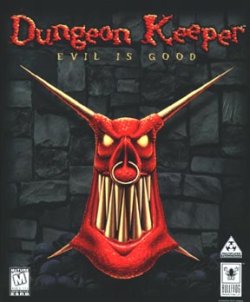
Dungeon Keeper is a strategy video game developed by Bullfrog Productions and released by Electronic Arts in June 1997 for MS-DOS and Windows 95. In Dungeon Keeper, the player builds and manages a dungeon, protecting it from invading 'hero' characters intent on stealing accumulated treasures, killing monsters and ultimately the player's demise. The ultimate goal is to conquer the world by destroying the heroic forces and rival dungeon keepers in each realm. A character known as the Avatar appears as the final hero. Dungeon Keeper uses Creative Technology's SoundFont technology to enhance its atmosphere. Multiplayer with up to four players is supported using a modem, or over a local network.

Star Wars: Dark Forces is a first-person shooter video game developed and published by LucasArts. It was released in 1995 for MS-DOS and Macintosh, and in 1996 for the PlayStation. The story is set in the fictional Star Wars expanded universe and begins shortly before the original Star Wars film, before flashing forward to a year after the film's events. The game's protagonist and playable character is Kyle Katarn, a mercenary working on behalf of the Rebel Alliance who discovers the Galactic Empire's secret Dark Trooper Project, which involves the development of a series of powerful new battle droids and power-armored stormtroopers.

Star Wars: Force Commander is a real-time strategy video game released for the Microsoft Windows platform in 2000. It was co-developed by Ronin Entertainment and LucasArts, and published by LucasArts. Its plot interweaves between Star Wars: A New Hope and Return of the Jedi, taking place in key battles. Peter McConnell created remixed tracks of John Williams's original score with influences from hard rock and techno music.

Star Wars: Rebel Assault is a rail shooter video game developed and published by LucasArts for DOS, Macintosh, Sega CD and 3DO Interactive Multiplayer systems, set in the Star Wars universe. Released in 1993, it is the first CD-ROM-only game to be published by LucasArts. The game's story focuses on a young pilot called Rookie One as they are trained by, and subsequently fights for, the Rebel Alliance in the Galactic Civil War.

Star Wars: Yoda Stories is a 1997 adventure video game based on the Star Wars franchise developed by LucasArts. The game is the second and last title in LucasArts' Desktop Adventures series, preceded by Indiana Jones and His Desktop Adventures. The game was released in March 1997 for Microsoft Windows and ported to Game Boy Color by Torus Games in December 1999.
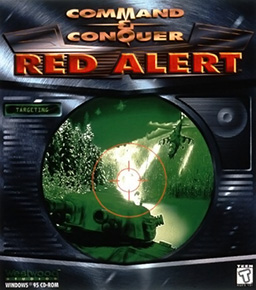
Command & Conquer: Red Alert is a real-time strategy video game in the Command & Conquer franchise, developed and published by Westwood Studios in 1996. The second game to bear the Command & Conquer title, Red Alert is the prequel to the original Command & Conquer of 1995, and takes place in the alternate early history of Command & Conquer when Allied Forces battle an aggressive Soviet Union for control over the European mainland.
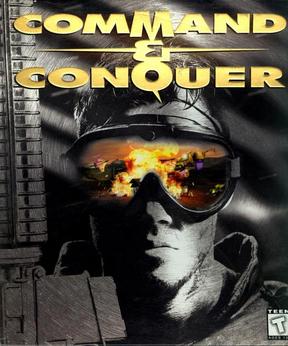
Command & Conquer is a real-time strategy video game developed and published by Westwood Studios in 1995. Set in an alternate history, the game tells the story of a world war between two globalized factions: the Global Defense Initiative of the United Nations and a cult-like militant organization called the Brotherhood of Nod, led by the mysterious Kane. The groups compete for control of Tiberium, a mysterious substance that slowly spreads across the world.
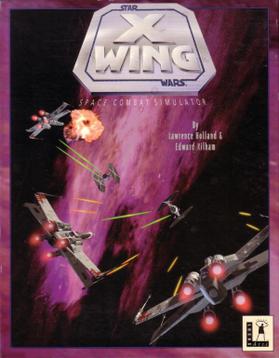
Star Wars: X-Wing is a space simulation video game, the first of the X-Wing combat flight simulation games series. The player's character flies starfighters, including the X-wing, for the Rebel Alliance. The narrative precedes and parallels the events of Star Wars Episode IV: A New Hope.

Hind is combat flight simulation game released by Digital Integration in 1996 for MS-DOS compatible operating systems and Microsoft Windows. It is the successor to Apache.
Star Wars: Jedi Knight is a series of first- and third-person shooter video games set in the fictional Star Wars expanded universe. The series focuses primarily on Kyle Katarn, a former Imperial officer who becomes a mercenary working for the Rebel Alliance, and later a Jedi and instructor at Luke Skywalker's Jedi Academy. While the first game is set a year after the events of A New Hope, the sequels take place in the decade following Return of the Jedi.
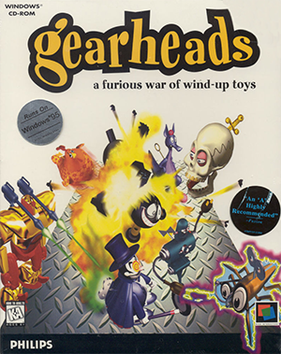
Gearheads is a strategy video game developed by R/GA Interactive and Philips Media, and published by Philips Media for Microsoft Windows and Mac OS in June 1996. The player deploys wind-up toys to get them across an arena while attempting to prevent toys from crossing from the other side. Players can play against the computer or another player. Single, customisable games can be played, or the player can play a series of games with set rules and a limited number of lives in a tournament.

Star Wars Jedi Knight: Mysteries of the Sith is an expansion pack for the 1997 first-person shooter Star Wars Jedi Knight: Dark Forces II, developed and published by LucasArts for Microsoft Windows in 1998. It was re-released on Steam in September 2009. The expansion includes a new single-player story mode and fifteen multiplayer maps. The single-player story, set in the fictional Star Wars expanded universe five years after the events of Dark Forces II, follows both returning protagonist Kyle Katarn, a Jedi Master and mercenary working for the New Republic, and Mara Jade, a character featured in numerous Star Wars expanded universe works, who is being trained by Katarn in the Jedi arts. After Katarn goes missing while investigating an ancient Sith temple, Jade continues her studies on her own while undertaking missions from the New Republic, eventually leaving to find Katarn.
